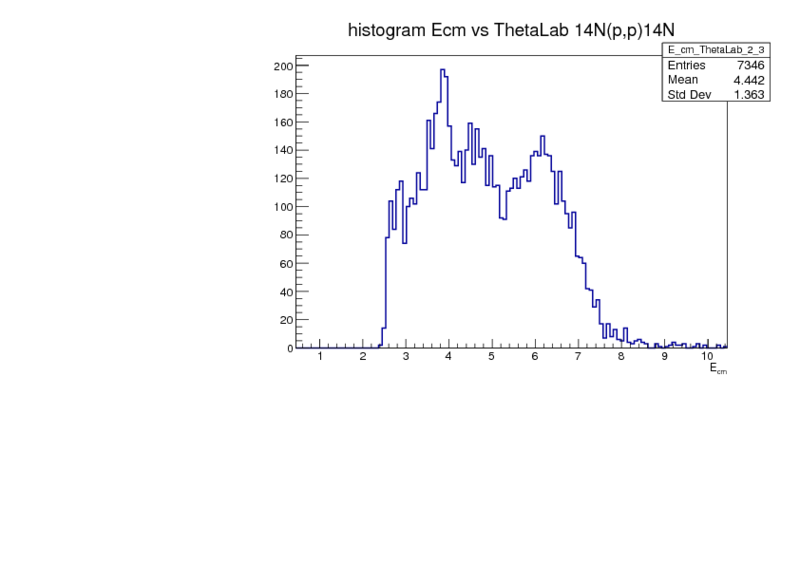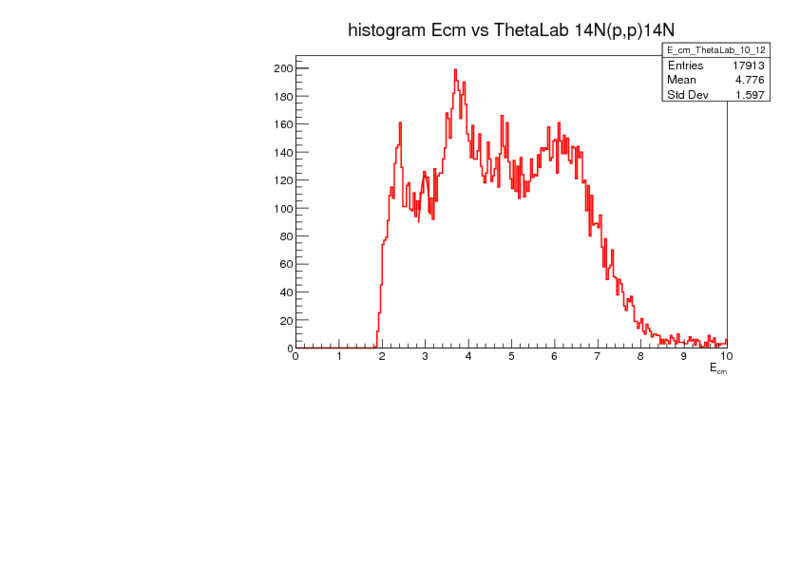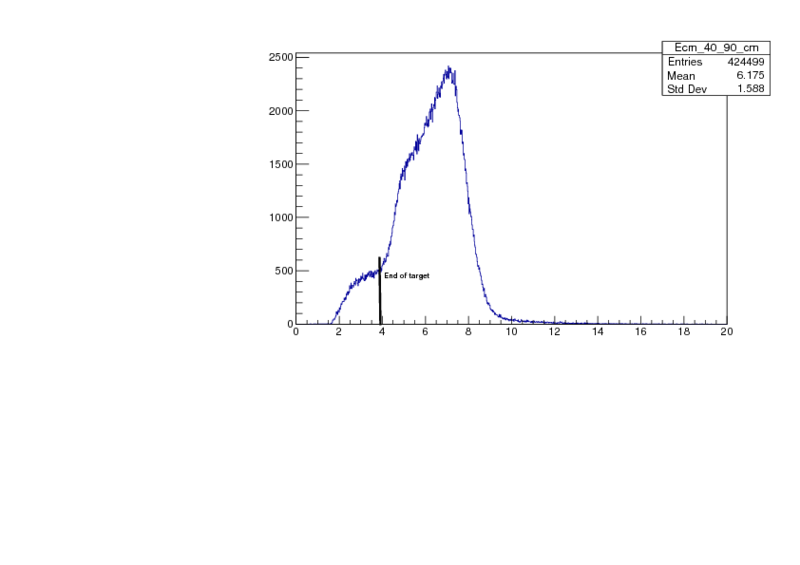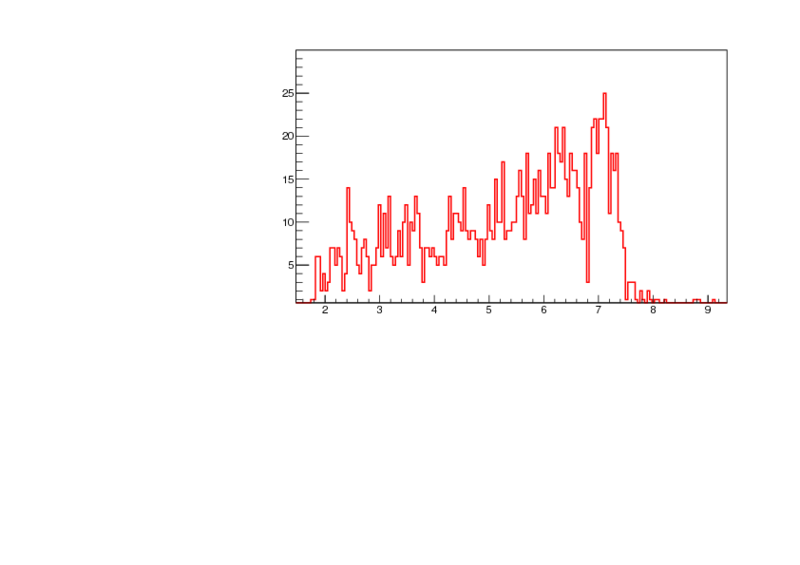Status |
ExpNbr |
Date |
Author |
Type |
Category |
Target-Source |
Subject |
| Ongoing | e744 |
Thu May 24 02:30:52 2018 |
iulian | RUN | General | N/A | RUN 440 14N no target trigger Must & cats %100 |
RUN 440
14N beam \
no target
trigger t1-t5
cats %100
some counts in t5. Very low transmission . max 30 while in cats we had 500 |
| Attachment 1: run440.png
|

|
| Ongoing | e744 |
Thu May 24 05:59:44 2018 |
iulian | MUST2 | General | N/A | run 444 t1-t4 trigger no target 14n beam |
run 444
t1-t4 trigger
no target
14n beam |
| Attachment 1: mm5_8_run445.png
|

|
| Attachment 2: mm5_7_run444.png
|

|
| Attachment 3: mm5_6_run444.png
|

|
| Attachment 4: mm5_5_run444.png
|

|
| Attachment 5: mm5_4_run444.png
|

|
| Ongoing | e744 |
Thu May 24 06:30:27 2018 |
iulian | RUN | General | N/A | run 445 t1-t4 trigger no target 14n beam no CATS |
|
| Attachment 1: mm5_run445_3.png
|

|
| Attachment 2: mm5_run445_2.png
|

|
| Attachment 3: mm5_run445_1.png
|

|
| Ongoing | e744 |
Fri May 25 02:57:44 2018 |
Valerian and Iulian | OFFLINE | General | CH2 | Simulation Azure 1H(14N,p) and measurement |
We can know conclude without any doubt that we were able to measure resonances from 1H(14N,p)14N. The resolution with a rough analysis and the current bad calibration is around 180keV in the com.
Identification of resonances is still difficult but some structure seems consistent with previous works. Also, at higher energy there are only few measurement so the data taken with 14N this night should be interesting.
First spectra is simulated with AZURE2
Second spectra is Energy in center of mass for ThetaLab between 0 to 4 degrees (T5)
Third spectra is Energy in center of mass for ThetaLab between 2 to 3 degrees (T5)
Fourth spectra is Energy in center of mass for ThetaLab between 10 to 12 degrees (T1-T4)
Fifth spectra is Energy in center of mass for ThetaLab between 15 to 20 degrees (T1-T4) |
| Attachment 1: o15.pdf
|

|
| Attachment 2: E_cm_ThetaLab_0_4.pdf
|

|
| Attachment 3: E_cm_ThetaLab_2_3.pdf
|

|
| Attachment 4: E_cm_ThetaLab_10_12.pdf
|

|
| Attachment 5: E_cm_ThetaLab_15_20.pdf
|

|
| Ongoing | e744 |
Fri May 25 15:10:23 2018 |
François | CATS | Hardware | | delay on CATS |
| CATS delay 500 ns was changed to 300 ns, in order to get the stop signal on MUST2 TAC well within the range of the TAC. |
| Ongoing | e744 |
Fri May 25 15:19:38 2018 |
Cristina | OFFLINE | General | | isomers present in the 14N runs |
Attached are some pictures of the energy_vs_time spectra for EXL and PPT detectors recorded during 14N runs
Still to do: time alignment of EXL detectors |
| Attachment 1: 14Nruns_isomers_EXL.pdf
|

|
| Attachment 2: 14Nruns_isomers_PPT.pdf
|

|
| Ongoing | e744 |
Fri May 25 16:49:53 2018 |
e748 | MUST2 | General | CH2 | Raw dE-TOF bidim for the 5 telescopes zith the 14N beam |
| Pedestal seems not to be aligned for T4 |
| Attachment 1: Example1.png
|

|
| Ongoing | e744 |
Fri May 25 23:15:57 2018 |
Valerian | OFFLINE | General | CH2 | Oxygen 15 excitation function |
| After a quick analysis, we can conclude that MUST2 is working for resonant elastic scattering. We find a resolution of 125 keV which will improve with a better analysis, as we are using a basic calibration for CsI Energy. |
| Attachment 1: Exc_15O.pdf
|

|
| Ongoing | e744 |
Sat May 26 03:23:46 2018 |
Valerian | OFFLINE | General | CH2 | 15O excitation function as a function of ThetaLab |
|
| Attachment 1: Ex_15O.pdf
|

|
| Ongoing | e744 |
Sat May 26 05:02:42 2018 |
Valerian | TARGET | General | CH2 | Problem with the target for run 2004 and 2010 |
The target seems identical between the two runs... We will have to investigate to understand what is going on.
The decision is to change the target 5 for the target 4 104um from georges.
The two spectras from run 2003 (target nr6) and 2010 (target nr 5) are identical. The peak at low energy correspond to the first excited state in 15F.
In the picture, target N°4 is written 104 µm
N°5 100 µm GoodFellow
N°6 187µm |
| Attachment 1: Target_Issue_2004_2010.png
|

|
| Attachment 2: targets.jpg
|

|
| Ongoing | e744 |
Sat May 26 07:03:12 2018 |
Valerian and Iulian and Francois | OFFLINE | General | CH2 | First picture for 15F from runs 2010-2013 |
Target -> Thick target (Sandwich target ??)
The predictions are different....
At large angles, the 5/2+ peak (at 2.78 MeV) is cut because it goes to lower energies in lab. If the background at 4 MeV is normalized to the one at 0°, there is no very broad-resonance at high energy in large angles. |
| Attachment 1: Ex_15F_proj_0_8deg_17_27.pdf
|

|
| Attachment 2: sig_theo.jpg
|

|
| Ongoing | e744 |
Sat May 26 07:32:17 2018 |
Valerian, pedja, mihai | RUN | General | CH2 | Run 2015 after vacuum problem of Css1 target 4 |
Run 2015
26/05/18
start @7h29
stop @9h42 |
| Attachment 1: Scalers_start_run2015.png
|

|
| Ongoing | e744 |
Sat May 26 10:06:06 2018 |
Giuseppe, Dieter | RUN | General | CH2 | Run 2018 |
Run 2018
Start @ 09:56 26/05/2018
Stop @ 10:51 |
| Attachment 1: Scalers_start_run2018.png
|

|
| Attachment 2: Scalers_stop_run2018.png
|

|
| Attachment 3: MM_IMPACT_stop_run2018.png
|

|
| Ongoing | e744 |
Sat May 26 20:20:55 2018 |
Valerian | OFFLINE | General | CH2 | 15F observations for target 4 (100um) |
| Analysis offline permits us to conclude that the current target has the good size to observe our resonances. |
| Attachment 1: Ecm_Thetacm_target4_notes.pdf
|

|
| Attachment 2: Ex_15F_proj_0_4deg_Ecm_target4.pdf
|

|
| Attachment 3: Ex_0to40degEcm_15F.pdf
|

|
| Ongoing | e744 |
Sat May 26 20:23:52 2018 |
Cristina Iulian | OFFLINE | General | | PPT gamma spectrum |
| Attached is the gamma spectrum from PPT detector with a condition on prompt (T_MM_PPT), proton detected in MUST and multiplicity event equal to 1 |
| Attachment 1: runs_target4_proton_prompt_PPT.pdf
|

|
| Ongoing | e744 |
Mon May 28 02:07:41 2018 |
Valerian | OFFLINE | General | CH2 | New improved resolution for 14N et 15F |
After correcting position for the Must2 detectors by taking into account the real hit position on the target that was (0,15cm,0) and not (0,0,0). The way to do it was to artificially move every detector 15cm lower.
Joined are the results at 0deg, for 14N the resolution increases from 125keV to 102keV. |
| Attachment 1: Exc_15O_newpos.pdf
|

|
| Attachment 2: Exc_15F_newpos.pdf
|

|
| Ongoing | e744 |
Mon May 28 20:28:50 2018 |
Valerian and Simon | OFFLINE | General | CH2 | Explanation for the 0 degree low energy proton |
| The 0 degree energy proton are coming from the beam hitting the aluminum target. If you do a cut on the beam projection on T5 you obtain the black dot on the joined plot. |
| Attachment 1: explanation_spotT5.pdf
|

|
| Ongoing | e744 |
Mon May 28 23:14:26 2018 |
Valerian and Iulian and Phil | OFFLINE | General | CH2 | New hint of the 5/2- resonance |
| We see a new hint of a resonance |
| Attachment 1: New_resonance_hint.pdf
|

|
| Ongoing | e744 |
Tue May 29 00:17:18 2018 |
Night shifter | BEAM | General | Carbon | Beam intensity variation |
Beam shut down at 00h03. Increase the intensity progressively up to now 00h18.
At 0:28: primary intensity dropped down to 0. |
| Attachment 1: hv_run2103.png
|

|
| Ongoing | e744 |
Tue May 29 01:25:07 2018 |
Phil, Valerian, Franck | EXL-PPT | General | N/A | LaBr3 Background for reference |
For reference, we include a picture of the LaBr3 background found by some random Google searching until we found a nice happy looking picture.
Remember (I'd forgotten despite having literally had this conversation with someone in the past) that the LaBr3 internal background lies at exactly the same energy as the 40K room background (which is why LaBr3 isn't good for environmental monitoring, innit) so you don't know whether the peak there is from the internal activity or the 40K from the energy (however, on the basis of how much activity of each is around it's from the internal activity). |
| Attachment 1: Response-of-3-3-CeBr-3-and-LaBr-3-Ce-to-natural-background-radiation-Events-due-to.jpg.png
|

|